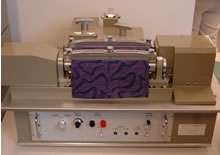Haptics: just reach out and touch, virtually

European researchers have pioneered a breakthrough interface that allows people to touch, stretch and pull virtual fabrics that feel like the real thing. The new multi-modal software linked to tactile hardware and haptics devices have enormous potential for shopping, design and human-machine interaction.
A revolutionary new interface allows users to really feel virtual textiles. The system combines a specially designed glove, a sophisticated computer model and visual representation to reproduce the sensation of cloth with an impressive degree of realism.
“It is a multi-modal approach that has never been tried before,” says Professor Nadia Magnenat-Thalmann, coordinator of the HAPTEX project. HAPTEX stands for Haptic sensing of virtual textiles.
The new system is a major breakthrough achieved through highly focused work of a small consortium of five research institutes. In just three years, they have created a pre-commercialisation prototype of the device and its related multi-modal software.
But it was not easy. Creating the realistic sensation of deformable textiles required a huge amount of modelling. “That was our first big challenge,” says Magnenat-Thalmann, taking precise measurements of the tensile, bending and stretching properties of the material.
“You also need very high resolution; the visual system will give a realistic impression of movement with just 20 frames a second, but touch is much more sensitive. You need a thousand samples a second to recreate touch,” she tells ICT Results.
Major challenges
In the end, the team created two models. One global model tracks the overall properties of the material. A second, fine-resolution model then maps the actual sensation on skin. All this information had to be combined with a detailed visual representation of the textile.
“That was another major problem,” notes Magnenat-Thalmann, “because the two must be in sync or the sensation will not be realistic.” Like a video with the audio out of sync, any latency between the visual and the sensual destroys the effect.
These were three major challenges from the outset, but they were just the beginning. “We had major jobs to do with the hardware, too. Nobody has combined a force-feedback device with a tactile one,” reports Magnenat-Thalmann.
HAPTEX overcame this problem by developing a powered exoskeleton glove with a pair of pin arrays that provide tactile sensation to two fingers. The glove gives the sensation of bending and stretching the fabric, while the pin arrays convey texture. Then this integrated device is combined with the visual and tactile database to give an overall impression.
Feeling is believing
“We have a working prototype device and we have validated it. It gives a reliable and reproducible sensation of real fabrics in a virtual world,” says Magnenat-Thalmann.
Reviewers were very impressed with the project’s results, but Magnenat-Thalmann says the project did not achieve all that they hoped for. “Originally, our vision was to create a system that allowed users to distinguish between, say, cotton, wool and silk in a blind test. The system is not that sensitive yet.”
It is, however, in pre-commercialisation form. The team now hopes to secure funding for a second project that will take the device from prototype stage to full commercialisation. If they succeed, it will be a first of its kind.
It will also mean entirely new markets. The textile industry and online shopping are obvious examples, but Magnenat-Thalmann also sees applications in gaming, where it could be used to make virtual worlds more realistic.
Source: ICT Results





















